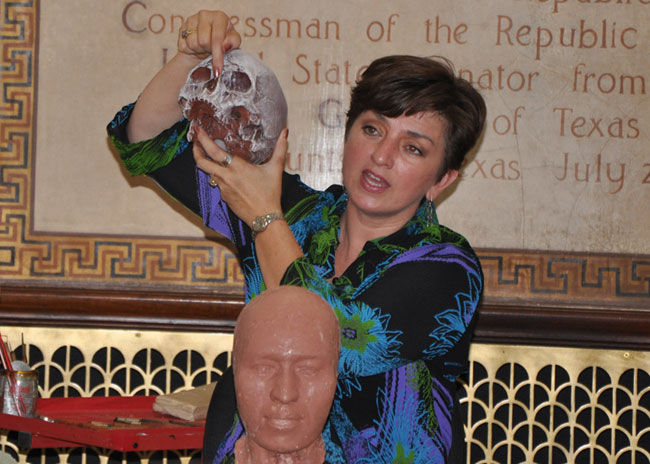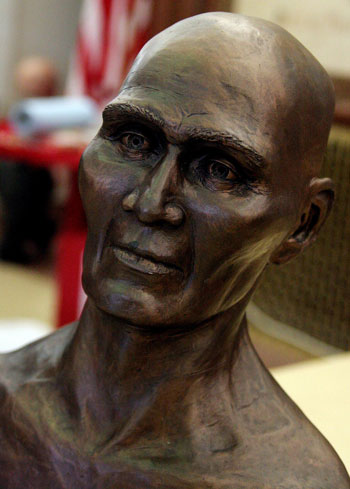Presentation To Show Science, Art Of Forensic Sculpting
Sept. 22, 2011
SHSU Media Contact: Beth Kuhles
 |
| Forensic sculptor Amanda Danning will return to SHSU on Oct. 12 to discuss her work recreating the image of "SAM," who was discovered buried in a cave near the Brazos River in Central Texas and whose skull predates Native Americans. —Submitted photos. |
A Mexican soldier who died at the San Jacinto Battleground had his head bashed in with a rifle butt, but that’s not what killed him, according to forensic sculptor Amanda Danning.
“He heals from this blow, and he goes out to fight again,” the facial reconstructionist said. “He gets to go back to San Jacinto, lucky fellow.”
Using science and art, Danning is able to capture the faces of historic figures who lived hundreds and sometimes thousands of years ago.
During a visit in April, Danning discussed a project for which she recreated the faces of five Mexican soldiers who died at the Battle of San Jacinto in 1836, when Texas earned its independence from Mexico and become its own country. Danning was able to recapture the injuries suffered by the soldiers.
Danning, who was commissioned by the Friends of the San Jacinto Battleground, discussed two versions she sculpted of Mexican Solider No. 556, one as he looked before his injuries and one on the day of the battle.
“He was hit with a rifle butt on the top of his nose a year earlier,” she explained. “There was a seven millimeter depression, and bone would have came out of the flesh. It damaged the muscle of his right eye, and his eye would be lilted out to the right.”
Danning will return to campus in October as part of the Sam Houston Memorial Museum and the Texas Historical Commission’s Texas Archaeology Month celebration, discussing her newest project, “Face To Face With The Son Of America,” on Oct. 12 at the Katy & E. Don Walker, Sr., Education Center. A reception will begin the event at 6:30 p.m., followed by the presentation at 7 p.m.
The “Son of America,” also known as SAM, is one of the two most important anthropological finds in North America in the last century, according to museum marketing coordinator Megan Buro.
“Discovered buried in a cave near the Brazos River in Central Texas, SAM is estimated to be about 10,000 years old and is not related to Native Americans of today,” Buro said.
The skull of SAM predated Native Americans in the area and its features more closely resembled the Anyu of Japan, Nordics, or the Maasai of Africa. There were about 100 artifacts in his burial grounds, along with a child. The artifacts provide clues to his culture and lifestyle, according to Danning.
From what Danning can tell, SAM lived 300 miles from the coast, but he had a necklace made of coastal shells, possibly indicating trade in the area. He had tools to make other tools and his right arm was stronger than his left, with large forearms, indicating repetitive scraping or sharpening with his right hand. He was buried with hollowed out turtle shells on his face and stomach and a hawk claw in his mouth, indicating he may have been a man with spiritual gifts (the hawk was considered a messenger from the spirits) who was stopped by Mother Earth (commonly symbolized by the turtle)
The girl had a needle in her stomach, which was not strong enough to sew animal skins, indicating the possibility of woven cloth during the era.
To hone her craft and get the scientific evidence needed to support it, Danning regularly works with Douglas Owsley, director of anthropology at the Smithsonian Institute, as well as other bone experts at the Washington, D.C., museum, and legendary Houston trauma surgeon Dr. James “Red” Duke from the Texas Medical Center.
“I bring science and art together, with 90 percent of it science and 10 percent of it art,” Danning said. “I read the bones. I listen to the bones.”
 |
Danning's recreation of "SAM." |
Danning combines two methods of facial reconstruction in her specimens, the American version—which uses soft tissue depth markers—and the Russian method—which rebuilds the face using muscles, glands, fat sacs and skin. Using the combined techniques, she brings historical figures back to life, including Buffalo Soldiers, Jamestown settler and “SAM,” the Paleo American skull found in Central Texas.
“It combines my three favorite things—sculpting, researching history and talking,” Danning said.
By studying the skull, scientists can determine many characteristics, including the race, ethnicity, age and injuries to the individual. Smaller nose with opening far from the sinus indicate European ancestry from colder climates, a genetic mechanism to protect again pneumonia. Larger noses, with nasal openings close to the sinuses, and broader mandibles indicate people of African descent, who come from warmer climate.
The soft tissue depth markers, which are parts of erasers cut at precise heights, are placed strategically around the skull to build the face. Bones in the nose and bones, muscle and glands in the eyes guide the shape of those features.
At the Battle of San Jacinto, 700 Mexican soldiers and nine Texas soldiers lost their lives, and 30 more Texans were injured, including Sam Houston, who suffered a bullet wound to the ankle. A bullet was recently discovered at the endangered historic site with a bone fragment still attached.
The skulls were retrieved by James Audubon, who scoured the country in search of birds, and were part of the collection of George Morton. As part of the study, a CAT scan was taken of the skull to produce an exact replica for the reconstruction. Scientists and doctors studied the injuries to the skulls to determine cause of death or previous injuries.
One Mexican soldier had three gunshot wounds to the head, but only one of them was from the San Jacinto Battleground. Due to smooth edges to the wounds, anthropologists were able to determine two of the shots occurred a year before the battle. A second Mexican soldier suffered saber wounds, but only one lifted his skull up and probably killed him, Danning said. A third had a huge beveled hole in the head, and scientists were able to pinpoint the trajectory of the bullet that killed him on the battlefield.
The month of October was set aside as Archeology Month in Texas by the Texas Historical Commission to celebrate the state’s archeological heritage. According to the Texas Historical Commission’s website, this gives Texans an opportunity to learn about their heritage, the historical significance of the state’s archeological sites, the importance of appropriate archeological practices, and the contributions made by professional and avocational archeologists.
During the presentation at SHSU, Danning will recount the story of how SAM was discovered, describe her forensic sculpting technique, and explain the significance of the trove of artifacts that were found buried with him.
A video of Danning's previous presentation can be found here.
- END -
This page maintained by SHSU's Communications Office
Director: TBD
Assistant Director: Julia May
Writer: Jennifer Gauntt
Located in the 115 Administration Building
Telephone: 936.294.1836; Fax: 936.294.1834
Please send comments, corrections, news tips to Today@Sam.edu.

 SamWeb
SamWeb My Sam
My Sam E-mail
E-mail

